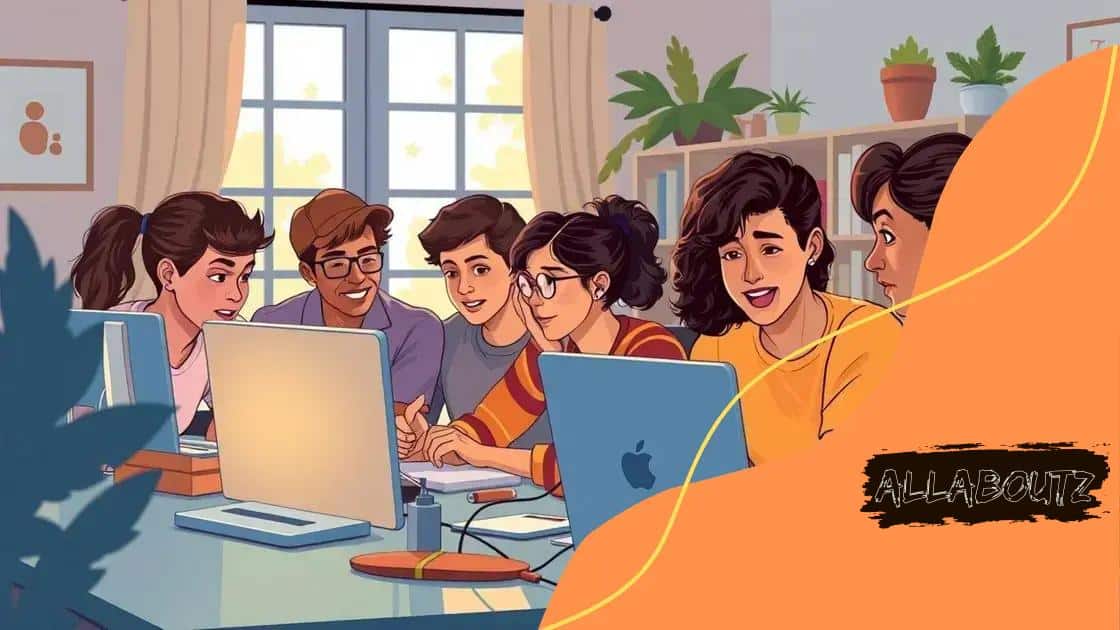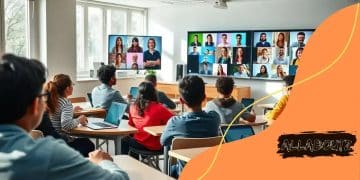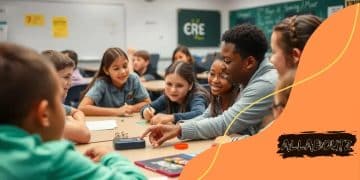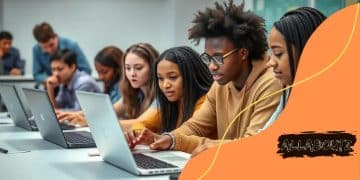The impact of virtual classrooms on student collaboration

The impact of virtual classrooms on student collaboration includes enhanced communication and teamwork, personalized learning opportunities, and the use of advanced technologies, while also posing challenges like communication barriers and differing motivation levels.
The impact of virtual classrooms on student collaboration is transforming traditional learning methods. Ever wondered how online learning changes the way students interact and collaborate? Let’s dive into this fascinating topic.
Understanding virtual classrooms
Understanding virtual classrooms is crucial in today’s educational landscape. With technology evolving, classrooms have moved online, enabling students to learn from anywhere. This shift has brought forth new possibilities and challenges in the way students engage with each other.
Defining virtual classrooms
A virtual classroom is an online learning environment where instructors and students can interact in real-time. These classes often use video conferencing tools, chat rooms, and digital whiteboards, providing a space where collaboration can thrive.
Benefits of virtual classrooms
- Flexibility: Students can learn at their own pace and on their own schedule.
- Access: Learners from different geographical locations can easily participate.
- Engagement: Interactive elements like polls and quizzes keep students involved.
Moreover, virtual classrooms encourage diverse communication styles. Students can express themselves through chat, voice, and video, helping to cultivate a rich learning environment. Using various tools, they can collaborate on projects and share ideas efficiently.
While there are many benefits, challenges exist as well. Technical issues can disrupt learning, and students might struggle with self-motivation. Therefore, it’s important for educators to create structured environments to support student growth.
By understanding how virtual classrooms operate, both teachers and learners can optimize their experiences. Engaging actively in discussions and utilizing collaborative tools can enhance the learning process immensely.
Benefits of collaborative tools
Benefits of collaborative tools in virtual classrooms are significant and can greatly enhance the learning experience. These tools allow students to work together, even when they are miles apart. They not only support communication but also foster teamwork among students, making learning more engaging.
Enhancing communication
Collaborative tools help students express their ideas and ask questions easily. Whether using instant messaging or discussion boards, students can interact and share opinions in real time. This leads to a more dynamic classroom environment.
Improving organization
- Shared documents keep everyone updated.
- Task management tools help track assignments.
- Calendar integrations ensure deadlines are met.
By staying organized, students can work more effectively. They can focus on the content of their projects instead of worrying about logistics. With a variety of cooperative platforms available, it’s easier for teams to manage their work together.
Moreover, using collaborative tools teaches students critical skills for their future. They learn how to collaborate in a team, respect differing opinions, and delegate tasks effectively. These are essential skills in today’s workforce. As they share resources and responsibilities, students become more accountable for their learning.
Many platforms allow students to give feedback on each other’s work. This peer review process helps deepen understanding and encourages a sense of community. By actively engaging in discussions and providing constructive feedback, students can improve their own skills and support their peers.
Challenges in student collaboration

Challenges in student collaboration are important to understand as virtual classrooms become more common. While these environments offer many advantages, they also present unique difficulties that can affect the learning experience.
Communication barriers
One major challenge is the lack of face-to-face interaction. In a physical classroom, body language and tone help convey messages. Online, these cues are often missing, leading to misunderstandings among students. Without clear communication, collaboration can falter.
Differences in motivation
- Students have varying levels of interest.
- Some may prefer working alone.
- Group dynamics can affect participation.
This can create tension within teams. When a few members are proactive while others are disengaged, it can diminish the overall success of group projects. This mismatch can lead to frustrations and conflicts, making it crucial to find ways to motivate all contributors.
Moreover, technical issues can interrupt collaboration. Slow internet connections or software failures can disrupt meetings and make it hard for students to stay focused. When technology fails, students may feel frustrated and less inclined to participate.
Teaching students how to effectively collaborate online is essential. They need strategies to communicate clearly and manage their tasks efficiently. Encouraging regular check-ins and using structured activities can help students stay on track and engaged.
Best practices for online group work
Best practices for online group work are essential for successful collaboration in virtual classrooms. By following these guidelines, students can enhance their teamwork and improve outcomes while working online.
Clear roles and responsibilities
Assigning specific roles to each group member is crucial. This helps everyone understand what is expected of them. Roles might include a leader, a researcher, a note-taker, and a presenter. Clearly defined roles can reduce confusion and ensure that tasks are completed on time.
Regular communication
- Schedule consistent meeting times.
- Use chat tools for quick updates.
- Encourage open discussions for feedback.
Regular communication helps the group stay connected and aligned. Students should feel comfortable sharing their thoughts and asking questions. Tools like video calls and group chats can facilitate ongoing dialogue and help build relationships.
Another important practice is setting goals for the group. Having clear objectives helps keep everyone focused and motivated. Students can break down larger tasks into smaller, manageable goals. This way, they can celebrate progress and stay engaged in the work.
Using collaboration tools effectively can also enhance online group work. Platforms like Google Docs or Trello allow students to work together seamlessly. These tools enable real-time editing and tracking of project progress, promoting active participation.
Lastly, students should remain flexible. Online collaboration may not always go as planned, and it’s essential to adapt. If challenges arise, groups should take a moment to reassess their approach and find new solutions together.
Future of virtual classrooms
Future of virtual classrooms is a topic of great interest as education continues to evolve. With advancements in technology, virtual classrooms are likely to become even more immersive and accessible.
Integration of advanced technologies
One key trend is the integration of technologies like virtual reality (VR) and augmented reality (AR). These tools can create engaging environments where students can explore information in a hands-on way. Imagine a biology class where students can interact with 3D models of cells or a history class that takes them on a virtual tour of ancient civilizations. This level of interaction can enhance learning and retention.
Personalized learning experiences
- Adaptive learning platforms cater to individual needs.
- AI can help identify areas for improvement.
- Customized resources keep students engaged.
Another exciting development is the rise of personalized learning. With the help of artificial intelligence, educational platforms can adapt to each student’s pace and style. This means that students get the support they need, making learning more effective and enjoyable.
Collaboration is also set to grow in importance. As more students participate in online learning, the need for robust platforms that facilitate group work will increase. Future virtual classrooms will likely use tools that make collaboration seamless, such as virtual breakout rooms where students can discuss projects in real-time.
Additionally, accessibility will improve as internet connectivity expands globally. More students, regardless of their location, will have the opportunity to participate in virtual classrooms. This can help bridge educational gaps and provide quality learning experiences to many.
FAQ – Questions about the impact of virtual classrooms on student collaboration
How do virtual classrooms enhance student collaboration?
Virtual classrooms provide tools that encourage teamwork, making it easier for students to communicate and share ideas.
What are some challenges students face in virtual collaboration?
Students may struggle with communication barriers, differences in motivation, and technical issues when collaborating online.
What best practices can improve online group work?
Establishing clear roles, maintaining regular communication, and using effective collaboration tools can enhance online group dynamics.
What does the future hold for virtual classrooms?
The future likely includes advancements in technology, personalized learning experiences, and broader access to quality education for students worldwide.





